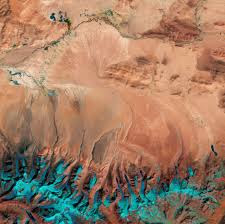Seismic information clarifies mainland impact underneath Tibet
Notwithstanding being the last skyline for globe-trotters and otherworldly searchers, the Himalaya district is an ideal spot for understanding land measures.
It has top notch mineral stores of copper, lead, zinc, gold and silver, just as more uncommon components like lithium, antimony and chrome, that are fundamental to current innovation. The inspire of the Tibetan level even influences worldwide atmosphere by impacting environmental flow and the advancement of occasional storms.
However in spite of its significance, researchers actually don't completely comprehend the geographical cycles adding to the locale's development. "The physical and political unavailability of Tibet has restricted logical investigation, so most field tests have either been too confined to even consider understanding the master plan or they've needed adequate goal at profundities to appropriately comprehend the cycles," said Simon Klemperer, a geophysics educator at Stanford's School of Earth, Energy and Environmental Sciences (Stanford Earth).
Presently, new seismic information assembled by Klemperer and his associates gives the principal west-to-east perspective on the subsurface where India and Asia impact. The exploration adds to a progressing banter over the structure of the Himalaya impact zone, the main spot on Earth where mainland plates keep smashing today - and the wellspring of fiascoes like the 2015 Gorkha seismic tremor that killed around 9,000 individuals and harmed thousands more.
The new seismic pictures propose that two contending measures are all the while working underneath the impact zone: development of one structural plate under another, just as diminishing and breakdown of the outside. The examination, led by researchers at Stanford University and the Chinese Academy of Geological Sciences, was distributed in Proceedings of the National Academy of Sciences Sept. 21.
The examination denotes the first occasion when that researchers have gathered really sound pictures of what's called an along-strike, or longitudinal, variety in the Himalaya impact zone, co-creator Klemperer said.
As the Indian plate crashes into Asia it structures Tibet, the most noteworthy and biggest mountain level on earth. This cycle began as of late in topographical history, around 57 million years prior. Scientists have proposed different clarifications for its arrangement, for example, a thickening of the Earth's outside brought about by the Indian plate driving its way underneath the Tibetan Plateau.
To test these speculations, scientists started the major strategic exertion of putting in new seismic recorders in 2011 so as to determine subtleties that may have been recently neglected. Critically, the new recorders were introduced from east to west across Tibet; customarily, they had just been sent from north to south since that is the bearing the nation's valleys are arranged and subsequently the course that streets have verifiably been constructed.
The last pictures, sorted out from chronicles by 159 new seismometers firmly separated along two 620-mile long profiles, uncover where the Indian hull has profound tears related with the arch of the Himalayan bend.
We're seeing at an a lot better scale what we never observed," Klemperer said. "It required a gallant exertion to introduce firmly dispersed seismometers over the mountains, rather than along the valleys, to gather information in the west-east heading and make this exploration conceivable.
Building and breaking
As the Indian structural plate moves from the south, the mantle, the thickest and most grounded aspect of the plate, is plunging underneath the Tibetan level. The new investigations uncover that this cycle is making little pieces of the Indian plate sever underneath two of the surface cracks, likely making tears in the plate - like how a truck hurtling through a thin hole between two trees may chip off bits of tree trunk. The area of such tears can be basic for seeing how far a significant tremor like Gorkha will spread.
"These changes, these hops between the issues, are so significant and they're at a scale that we don't ordinarily see until after a seismic tremor has occurred," Klemperer said.
An irregular part of Tibet includes the event of exceptionally profound seismic tremors, in excess of 40 miles underneath the surface. Utilizing their seismic information, the scientists discovered relationship between the plate tears and the event of those profound shakes.
The exploration likewise clarifies why the quality of gravity shifts in various pieces of the impact zone. The co-creators speculated that after the little pieces dropped off of the Indian plate, gentler material from underneath rose, making mass uneven characters in the India-Tibet impact zone.
A characteristic research center
The India-Tibet area additionally gives knowledge into how parts of the eastern U.S. could have been shaped through mainland crashes around a billion years back.
The best way to comprehend what may have occurred in eastern North America today is to come to Tibet," Klemperer said. "For geologists, this is the one major mainland impact that is occurring on Earth today - it's this regular research center where we can contemplate these cycles.
Story Source:
Materials gave by Stanford University.
Unique composed by Danielle Torrent Tucker.
Note: Content might be altered for style and length.
Know Kolar Gold
Visit Official Home Page








0 Comments